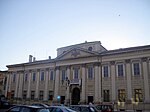Mantova railway station

Mantua Railway Station (Italian: Ferrovie Stazione di Mantova) is the main station of Comune of Mantua in the Region of Lombardy, northern Italy. The station, situated at Piazza Don Leone and northwest of the city centre, was opened in 1873. It is a junction of three railway lines: Verona-Modena Railway, Milan-Mantua Railway and Mantua-Monselice Railway (which connects to Padua). There was a fourth railway line, the now defunct Mincio Valley Line (to Peschiera del Garda), which terminated at Mantua until 1967. The station is currently managed by Rete Ferroviaria Italiana (RFI). The commercial area of the passenger building, however, is managed by Centostazioni. Train services are operated by Trenitalia and Trenord, Lombardy's regional transport agency. All of the above companies, except Trenord, are wholly owned subsidiaries of Ferrovie dello Stato (FS), Italy's state-owned rail company. FS holds 50% ownership of Trenord through Trenitalia; Trenord's other 50% shares are held by former Milan's railway agency, LeNord.
Excerpt from the Wikipedia article Mantova railway station (License: CC BY-SA 3.0, Authors, Images).Mantova railway station
Viale Pitentino,
Geographical coordinates (GPS) Address Nearby Places Show on map
Geographical coordinates (GPS)
| Latitude | Longitude |
|---|---|
| N 45.158888888889 ° | E 10.783611111111 ° |
Address
Viale Pitentino
46100 , Valletta Paiolo
Lombardy, Italy
Open on Google Maps











